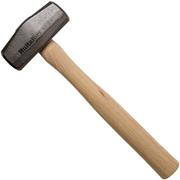

You have an outdated webbrowser. The website might not work correctly.
Hammers are essential tools for almost every DIYer, woodworker and professional. They are used to drive in nails, secure joints or tap materials loose and tap gouges or chisels. From carpentry to light demolition jobs: with the right hammer you work safely and effectively. There are different types of hammers, such as claw hammers, mallets and bench hammers. Well-known brands such as Estwing and Hultafors are known for their quality and durability.






























You choose the best hammer based on the type of work and your personal preference. In general, the heavier the hammer head, the more force you can exert - but at the expense of precision. For long-term use, choose an ergonomic handle and a well-balanced design.
Hammers come in all shapes and sizes, each designed for a specific application. Whether you want to hammer in a nail, pry loose a component or perform precision work, there is always a hammer to suit the job. Below, we will highlight the most common types of hammer.
The claw hammer is perhaps the best-known kind. You use it not only to hammer nails into wood, but thanks to the curved claw at the back, also to easily remove nails again. Moreover, you can use the same claw to pry off wooden parts, for example. A real all-rounder for chores around the house.
This hammer has a flat, rectangular head and a relatively narrow pin at the other end. It is often used for metalworking, light assembly work and precision work. Thanks to its straight striking face, it is also ideal for tapping smaller parts or correcting metal.
The rubber hammer is perfect when you need to apply force without damaging the material. Ideal when fitting delicate materials such as wood, tiles, parquet or plastic parts. This hammer also comes in handy when assembling furniture or for light construction work.
The wooden mallet has a narrow, tapered head and is comfortable to hold. Thanks to its balanced weight, it is ideally suited to controlled blows, e.g. when working with chisels or gouges. Think of tasks like woodworking or sculpting.
For heavy-duty tasks; there's the sledgehammer. This hammer has a thick, heavy head that allows you to apply serious force. It is used in demolition work, breaking loose concrete or for driving in large wooden pegs or posts. Note: a sledgehammer requires a steady hand and good control, as the blows are heavy.
Although hammers require little maintenance, it is important to regularly check the handle and head for wear or loosening. Models with a steel or fibreglass handle are extra sturdy. For safe storage, a suspension system or tool case is recommended.